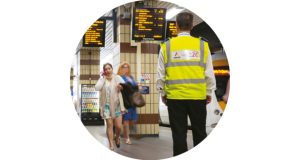A KEY ENABLER FOR SMART BUILDINGS
Many FM and property management teams include workplace experience apps as part of the services offered so that users get the most value out of their buildings. When mobile access is integrated with these apps, it makes access control an essential component, driving up app traffic given people have everything in one place on their phones. This makes mobile access an obvious tool to help CRE owners boost their net operating income (NOI). Happier tenants mean less churn, resulting in greater long-term revenue generation.
In addition, there’s always a focus on how to decrease operational costs. Data generated from access control systems – like the number of people entering and exiting a building, floor or room – combined with other building sensors help owners monitor and interact with their buildings far better. It is the door readers that provide this kind of granular data.
Perhaps one of the most exciting developments with mobile access control is the forthcoming availability of solutions with built-in ‘identity positioning’. This provides real-time information ‘behind the door’ about how people are using the building – based on data provided by their phones. This is certainly not “Big Brother” tracking an individual’s movements. No personal and private data is collected. Rather, information is anonymised and grouped in order to provide an overall picture about trends like space utilisation, occupancy and so on.
It moves access control from just being a security solution to one that takes on a far more important role in a smart building as identity positioning adds the context of location. Take a simple example. By providing real-time data like this to an appropriate HVAC system, the AC could be turned up automatically if a group of 20 people gather in a meeting room. Similarly, workplace app developers could take ‘staff location’ to augment the solutions they provide.
In summary, mobile access solutions are evolving to help CRE owners and facility management staff differentiate their buildings, add value to tenants and make their operations ever more efficient. Not only that, but they’re cost effective and quick to deploy – ultimately making the job of busy facility managers more straightforward and productive.
A SMART BUILDING IN PRACTICE
 The new Skyliner skyscraper in Warsaw, Poland, is an example of how mobile access integrated with a feature-rich workplace app is being used today.
The new Skyliner skyscraper in Warsaw, Poland, is an example of how mobile access integrated with a feature-rich workplace app is being used today.
One of the tallest buildings in the capital at 195 metres high, Skyliner has 42 stories, 49,000 m2 of leasable space, with the lower levels dedicated to retail. The developer, Karimpol Group, installed a workplace platform developed by Hellopark – branded the SkylinerAPP – in conjunction with a HID Mobile Access solution and 300 Bluetooth-enabled HID door readers.
Staff use their Apple iOS and Android-based smartphones and the SkylinerAPP to physically access the building, reserve car parking places, book desks and conference rooms, as well as receive information about the building or events going on. It is also a tool to log maintenance requirements, with the building’s facility managers – VINCI Facilities Poland – then informed about them via the system so they can be dealt with promptly.
In terms of physical access control, the strategy involved segmenting the building and creating various zones based on usage: office space for tenants, free access areas for the public, along with underground parking. To keep everything as simple as possible, touchless entry has been introduced so as people pass the turnstiles in reception a lift is automatically called to take them to the correct level.
To date, 1,600 users are registered in the SkylinerAPP and tens of thousands of requests are made within it. The process of adding and authorising staff is also straightforward. On the backend, an office administrator first registers people in the building’s security management system. Each employee then downloads the SkylinerAPP by visiting Google Play or the Apple App Store. The system has also been designed so that tenants manage the virtual access credentials themselves – from within the SkylinerAPP – removing the overhead for VINCI Facilities Poland to do it for them.






